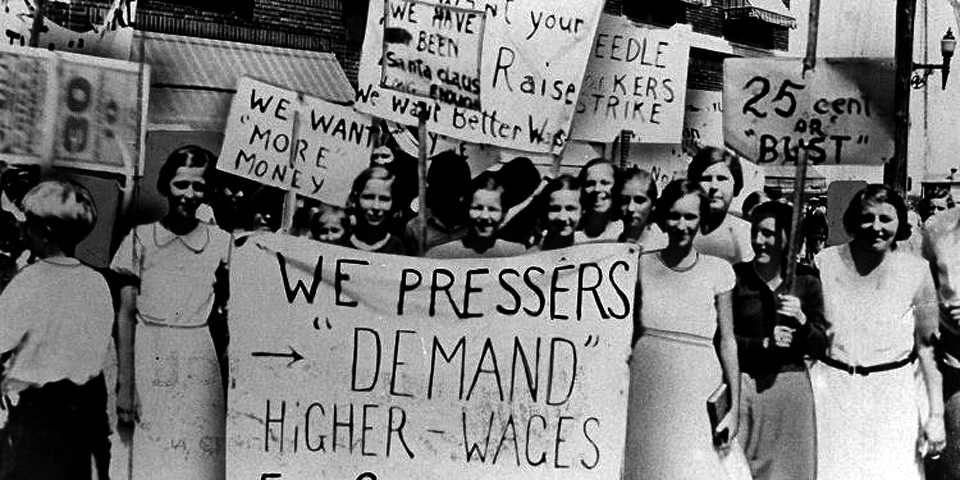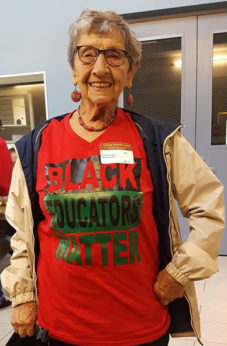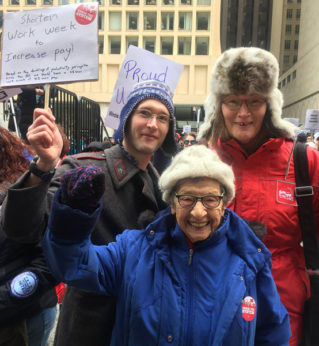
In the summer of 1937, the labor movement was exploding with the energy of a prairie fire. Millions of workers were flocking into the new CIO and millions more wanted in. I was not quite 19 but I answered the call to help organize the laundry workers of New York City. In two months, our staff of 30, half of us Communists, organized 20,000 workers. In a way, it was easy although there were hundreds of laundries, scattered around the five boroughs. All we organizers had to do was run as fast as we could from shop to shop (none of us had cars), answer the basic questions and write out the union cards as fast as our pens could move. Workers wanted a union and national law protected their right to join a union. Miserable wages, long hours, heavy work and racism had ground the laundry workers down. But now they had hope because the CIO was organizing.
I did not go back to school when the summer ended. The union work was too important and too exciting. But then the Amalgamated Clothing Workers Union took over our United Laundry Workers Industrial Union and raised my pay from $36.10 a week as a volunteer organizer to $36.20 a week. I bought my first suit! One month later, I was laid off and went out to work in a laundry. New workers then had a two-week trial period in which the boss could fire you without cause. In three weeks, I worked on six different jobs. On some, I lasted only half a day. I thought I had it made on the last job, but on the evening of the last day of the two weeks the familiar call came, “Beatrice, you are wanted in the front office.” Out of a job again, I decided to go back to school. At Hunter College the tuition was free, a benefit labor had won years earlier.

One year later I graduated but the Depression was still on. For most Hunter College graduates, then all women, the only jobs were sales clerks at Macy’s. But my family was on welfare and I did not have the clothing for that kind of job. I was able to get a job at a laundry in Brooklyn, where progressives had won the elections in Local 328. In the Spring of 1939, I returned to my life as a laundry worker at 35 cents/hour. It paid the rent for my furnished room, food if I did not eat too much, and essential clothing.
The Brighton laundry was one of the largest, with 500 workers. As an industrial union, our local included the higher-paid drivers, outside workers, and the lower-paid inside workers. In the days before apartments had washers and driers, most working families sent their laundry out, preferably on the traditional Monday washday. The hardest jobs were in the “kitchen” where big, strong men worked at steaming vats, pulling out heavy nets full of wet clothing. Before they had a union, the kitchen workers worked 16 hours on Mondays and Tuesdays. They did not bother to go home in between the 16-hour shifts, just caught naps stretched out on the nets of clothing.
Women did most of the other work in the laundries, ten-hour days at the beginning of the week and eight hours the rest of the week. First, the “shakers” shook out the wet clothing and stacked it for the “mangle girls.” Everything past the shaking table was hot, hot and hot. Some laundries had almost no ventilation. Normally, I do not sweat much so it was a weird sensation to have the sweat run down my legs into my shoes. It was not rare for women to faint. Wet cloths around the head and wrists helped. I tried working on the mangle where the feeder must keep the mangle covered at all times with clothes or linens properly stretched out to feed through without wrinkles. I tried, but a coworker said, “Beatrice has two speeds: Slow and stop.” So I became a “sleeve girl” in the shirt press department. I could do that quite well as I roasted between the hot sleeve forms and the steaming bosom press, back press, and collar and cuff press.

Finally, I reached the top of my trade as a skilled shirt folder. The shirt folder ironed the yoke and sleeve areas the presses did not reach. Then he/she folded the shirt and slipped it into an envelope. It was a strange thing to watch shirt folders at work. Arms, shoulders and back moved in rapid motions. That was natural because they were ironing, folding, inserting oh so fast. But their feet were also in constant motion, doing an unchoreographed dance. To the onlooker, there was no reason for this because no work was done with the feet. Strange thing! When I became a shirt folder, my feet began to dance on their own. There was no other way to maintain the intensely rapid motions of the arms and back without letting the feet dance. To touch up the shirts so quickly, the iron was kept intensely hot. I am afraid I scorched more than one shirt until I learned to move the iron fast enough. The piecework quota for the day was 300 shirts and I made my quota. But some did 500!
What difference did the union make? The job was still hot, hard, low paid and required long hours. Yes, the union brought in small pay increases and there was a limit put on the number of hours you could be forced to work. Those improvements were important, but small next to the gain in dignity and the right to be a human being. The foreman was no longer king, free to be abusive to the workers, especially women workers. He could no longer fire workers at will. Sexual harassment was not wiped out at once but the worst abuses were stopped. Most significant, openly abusive racist practices ended and multiracial unity grew among the laundry workers. As elsewhere in the CIO, African American and Latino workers, including women, rose to leadership in the union. They demanded and won respect from the companies.










